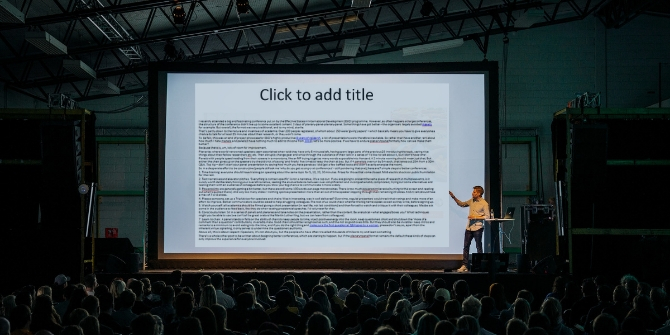Plenary + Panel Conferences Don’t Have to Be (So) Painful

I recently attended a big and fascinating conference put on by the Effective States in International Development program. However, as often happens at large conferences, the structure of the conference didn’t live up to some excellent content. Three days of plenary-panel-plenary-panel. Some things have got better – the organizers largely avoided manels, for example. But overall, the format was very traditional, and to my mind, sterile.
That’s partly down to the nature and incentives of academia. Over 200 people registered, of whom about 150 were ‘giving papers’ – which basically means you have to give everyone a chance to talk for at least 15 minutes about their research, or they won’t come.
To be fair, this was an end of project showcase for ESID’s highly productive eight years of research, a lot of presentations were therefore inevitable. So rather than have another rant about how much I hate manels and panels (I have nothing much to add to this one from 2016), let’s be more positive. If we have to endure plenary+panel formats, how can we make them better?
Because there is, um, lots of room for improvement.

Plenaries where world-renowned speakers seem astonished when told they have only five minutes left, having spent large parts of the previous 25 introducing the topic, saying nice things about their fellow researchers, etc. etc. Then abruptly change gear and whizz through the substance of their talk in a series of ‘I’d like to talk about X, but I don’t have time.’
Panels with people speed reading from their screens in a monotone, like an MP trying to get as many words as possible into Hansard. A 2-minute warning should mean just that. But either the chair gives up or the speakers try the old trick of saying ‘and finally’ five times to keep the chair at bay. But if four panelists overrun by five minutes each, that takes out 20 minutes from a 30-minute Q&A. Top tip – don’t start your panel presentation by saying how much you hate panels as I did (got a few baffled looks and didn’t exactly energize the room).
So in a desperate effort to be constructive (one person asked me ‘why do you get so angry at conferences’ – still pondering that one), here are seven simple steps to better conferences.
1. Time training: everyone should have training on speaking about the same topic for five, 10, 20, 30 minutes. Prizes for those that come closest. Mild electric shocks or public humiliation for the rest.
2. Test narratives and elevator pitches. ‘Everything is context-specific’ is not a narrative, it’s a cop out. If you are going to present the same piece of research in multiple events, is it surely worth deliberately honing your overall narrative, seeking the elusive balance between over-simplification and incomprehensibly complicated, trying out some alternatives and testing them with an audience of colleagues before you blow your big chance to communicate it more widely.
3. PowerPoints are generally getting a bit better, but there are still some 100 words-per-page monstrosities. There is too much PowerPoint karaoke (turning to the screen and reading out what’s quoted there). And way too many slides – nothing spoils a presentation more than an out of time speaker skipping through their remaining 20 slides. A 15-minute talk should have a max of seven or eight slides.
4. Please someone, set up a TripAdvisor for speakers and chairs: Was it interesting, was it well delivered? Over time, regular presenters would track their ratings and make more of an effort to improve. Better communicators could be asked to help struggling colleagues. The rest of us could check whether the big names speak as well as they write, before signing up.
5. Watch yourself: all academics should be filmed giving a short presentation (in real life, not lab conditions) and then forced to watch and critique it with their colleagues. Maybe ask some in the audience to feed back, like they do when testing presidential speeches. I’d volunteer for that.
6. Consciously listen: Sit in a series of panels and plenaries and take notes on the presentation, rather than the content. Be analytical – what engages/bores you? What techniques might you be able to use (we can’t all be great orators like Martin Luther King Jr., but we can learn from colleagues).
7. Learn to chair. A panel stands or falls on the ability of chairs to keep people to time, inject positive energy into the room, keep questioners short and shut down the ‘more of a comment than a question’ contributions, invariably male. Good chairs should be recognized as such, and the not so good ones ditto. But they should also be invisible – keep intros and remarks to a minimum to avoid eating into the time; and if you do the right thing and make sure the first question at Q&A goes to a woman, please don’t say so, apart from the inherent virtue signalling, it only serves to undermine the questioner’s authority.
Above all, this is about respect – speakers, it’s not about you, but the people who have often traveled thousands of miles to try and learn something.
There’s a whole other post to be written about designing better conferences, which are starting to happen, but if the plenary+panel format remains the default these kinds of steps can only improve the experience for everyone involved.




























































































